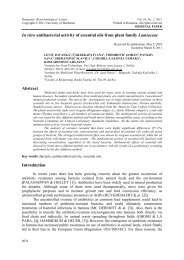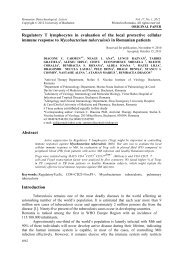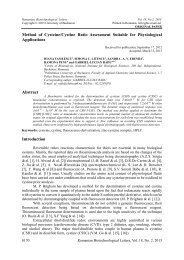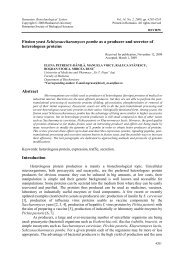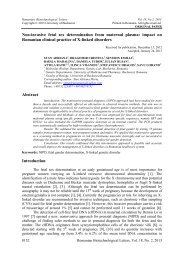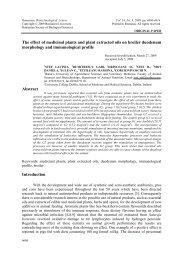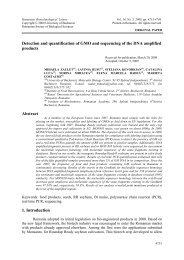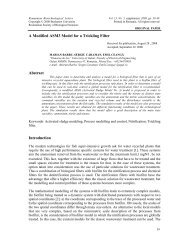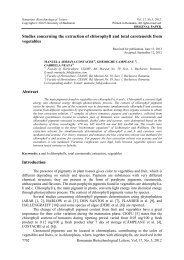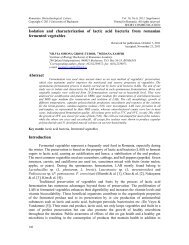(Pisum sativum L.) variety - Rombio.eu
(Pisum sativum L.) variety - Rombio.eu
(Pisum sativum L.) variety - Rombio.eu
Create successful ePaper yourself
Turn your PDF publications into a flip-book with our unique Google optimized e-Paper software.
MANJU BALA, T.N.NAG, KAVITA MATHUR, MANMOHAN VYAS, ANITA SAINI,<br />
BALVIR TOMAR AND SANDEEP KUMAR<br />
observed. Callus was observed along the midrib and margins of leaf. Complete callusing of<br />
explant was observed after 25-30 days of inoculation. The callus so obtained was greenish<br />
white in color.<br />
This callus was sub-cultured on MS media supplemented with 2, 4-D (1.5ppm), IAA<br />
(0.5ppm) and kinetin (0.5ppm). After 8 weeks, green and friable tissues were harvested.<br />
SHARMA & KAUSHAL [22] observed callus induction in pea on MS medium containing 2,<br />
4-D (2mg/l) when used leaf, epicotyls and root as explants. They also reported more callus<br />
formation from leaf explant for the various hormonal combinations tested by them. The callus<br />
produced from leaf explants in the present study was friable in nature and similar observation<br />
has also been reported by SHARMA & al. [27].<br />
Lectins were extracted from the seeds and callus tissues of pea (pisum <strong>sativum</strong> L.)<br />
<strong>variety</strong> (AP-1) using normal saline. The crude extract from seed showed haemagglutination<br />
activity of 800 HU/ml. The protein content was found to be 9.49 (mg/ml) and the specific<br />
haemagglutination activity of seed extract was 84.30 (Table1). In case of pea, lectin has<br />
already been reported in mature seeds by BAJAJ & SONI [20].The perusal of data in Table 1<br />
revealed that haemagglutination activity in callus tissues was also detected but it was low<br />
(100 HU/ml) as compared to seed extract activity.<br />
Table 1. Haemagglutination activity, protein content and specific haemagglutination activity of seed and callus<br />
extract of <strong>Pisum</strong> <strong>sativum</strong> L. <strong>variety</strong> AP-1<br />
Sample<br />
Haemagglutination activity<br />
HU/ml<br />
Protein<br />
mg/ml<br />
Specific activity<br />
HU/mg protein<br />
Seed extract 800 9.49 ±0.11 84.30 ±0.98<br />
Callus extract 100 4.42 ±0.03 22.59 ±0.16<br />
Each value is mean ±SD of three determinations.<br />
Protein content was 4.42 (mg/ml) and the specific haemagglutination activity was<br />
found to be 22.59 HU/mg protein. The results revealed that seed extract showed 4 times more<br />
specific haemagglutination activity than the callus extract. Whereas, SILVA & al. [9] reported<br />
that the specific haemagglutinating activity from crude callus extract (2.4 HU /mg) was<br />
comparable to that obtained from seeds (3.2 HU/ mg). Similarly, GUPTA & SRIVASTAVA<br />
[8] reported much higher haemagglutination activity in callus of Zizyphus mauritiana than<br />
its seeds. But in the present study, pea callus was found to be having less haemagglutination<br />
activity as compared to seeds. BHATTACHARYA & al. [5] also reported very less<br />
haemagglutinating activity of lectins during in vitro lectin production from Abrus cultures.<br />
Thermostability test revealed that lectin activity in seed and callus extracts was present<br />
up to 70⁰ C and 50 0 C, respectively. HOWARD & SAGE [28] showed that Lens culinaris<br />
lectin was stable up to 65 0 C. In our results, lectin from callus was found to be more<br />
thermolabile as compared to seed lectin as shown in Table 2.<br />
Table 2. Thermostability of lectins extracted from seed and callus extract of Pea (<strong>Pisum</strong> <strong>sativum</strong> L) Variety AP-1<br />
Exposure<br />
Haemagglutination activity (HU/ml)<br />
temperature (ºC)<br />
Seed extract<br />
Callus extract<br />
HU/ml % activity HU/ml % activity<br />
37 800 100* 100 100*<br />
40 800 100 100 100<br />
50 512 64 64 64<br />
60 256 32 ND ND<br />
70 128 16 ND ND<br />
80 ND ND ND ND<br />
Each value is mean ±SD of three determinations.<br />
ND Not detected<br />
Activity of preparation incubated at 37 ˚C was taken as 100 %<br />
5784 Romanian Biotechnological Letters, Vol. 15, No. 6, 2010



